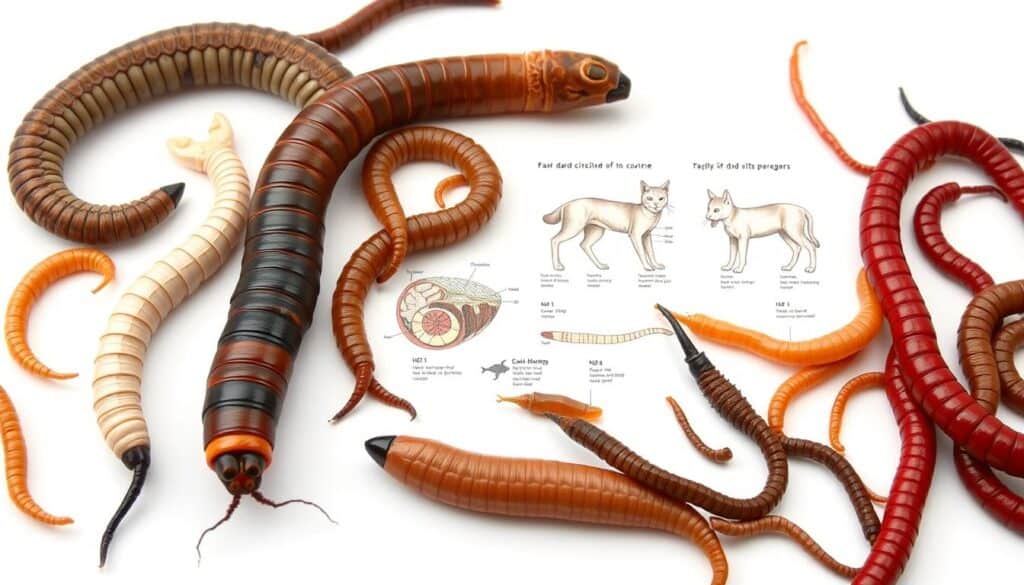Many pet owners share their beds with feline companions, but this cozy habit raises health concerns. The CDC reports that 50% of pet owners allow their pets to sleep alongside them. While comforting, close contact may increase exposure to parasites.
Cats can carry zoonotic threats like Toxoplasma gondii, a parasite linked to bedding contamination. Though rare, transmission occurs through accidental ingestion of infected particles. Understanding these risks helps owners make informed decisions.
This article explores evidence-based precautions to balance safety and snuggles. From flea control to hygiene practices, small steps reduce potential hazards without sacrificing bonding time.
How Worms Transfer from Cats to Humans
While cats make loving pets, their intestinal parasites may affect human health. Four common types infest felines: roundworms, tapeworms, hookworms, and whipworms. These parasites thrive in contaminated environments, posing risks through direct or indirect contact.
Common Types of Cat Worms
Roundworms are the most prevalent, often found in kittens. Tapeworms hitchhike via infected fleas, while hookworms latch onto skin. Whipworms, though rarer, persist in soil and feces. Each type follows unique transmission paths to humans.
Routes of Transmission
The fecal-oral route is primary. Cats shed parasite eggs in feces, contaminating litter boxes or bedding. Accidental ingestion occurs when handling soiled litter or touching faces before washing hands.
Fleas play a dual role—they carry tapeworm larvae. When cats groom, they ingest fleas, completing the parasite’s lifecycle. Outdoor cats add Toxoplasma gondii risks, tracking pathogens on paws.
Simple hygiene breaks the cycle. Regular deworming and flea control reduce risks significantly.
Can I Get Worms from My Cat Sleeping in My Bed? Assessing the Risk

Sharing a bed with pets offers comfort but requires awareness of parasite risks. While rare, contamination occurs through direct contact or environmental exposure. Understanding these pathways helps mitigate health concerns.
Direct vs. Indirect Contact Scenarios
Direct skin contact poses minimal risk, but indirect exposure is more concerning. Tapeworm segments, measuring up to 20 inches, can linger in bedding. These particles often originate from cat feces or flea ingestion.
Fabric materials trap parasite eggs, increasing environmental persistence. Regular washing at high temperatures reduces contamination. Flea-infested homes see a 4x higher tapeworm likelihood, linking pest control to parasite prevention.
Factors Increasing Infection Likelihood
Immunocompromised individuals face elevated risk. Their weakened defenses struggle against Toxoplasma gondii or roundworm larvae. Outdoor cats also heighten exposure by tracking pathogens indoors.
Key contributors include:
- Poor litter box hygiene
- Infrequent pet deworming
- High fleas population in the home
Proactive measures like monthly flea treatments and handwashing after pet interactions significantly lower transmission rates.
Types of Worms Cats Carry and Their Dangers

Not all cat parasites behave the same—some are more dangerous than others. While most infestations are treatable, certain worms cause severe damage if transmitted to humans. Recognizing these threats helps owners act swiftly.
Roundworms and Hookworms
Roundworms are spaghetti-like nematodes thriving in intestines. Their larvae migrate through organs, causing visceral damage. Hookworms latch onto skin or intestinal linings, leading to anemia.
Key risks include:
- Roundworm larvae invading lungs or eyes in humans
- Hookworm larvae penetrating bare feet during soil contact
Tapeworms and Rare Parasites
Tapeworms steal nutrients via segmented bodies. Common Dipylidium resembles moving rice grains. Rare Echinococcus forms cysts in human organs.
“Echinococcus infections, though uncommon, require urgent vet and medical intervention.”
Preventative steps:
- Schedule annual vet check-ups for deworming
- Inspect cat feces for visible worm segments
Preventing Worm Infections: Essential Hygiene Practices
Proactive measures shield families from zoonotic threats without sacrificing pet closeness. Combining vet-approved protocols with household habits creates a safe environment. These steps minimize risks while preserving the bond between owners and their pets.
Regular Deworming for Cats
Revolution and Advantage II prevent 98% of flea-borne infections, according to veterinary studies. Indoor and outdoor cats benefit from quarterly vet-approved deworming schedules. Prescription treatments target roundworms, tapeworms, and hookworms simultaneously.
Litter Box Maintenance
Daily scooping reduces contamination risk by 70%. Use gloves and EPA-approved disinfectants like bleach solutions (1:32 dilution) for weekly litter box sanitization. Covered boxes limit particle spread, but ensure proper ventilation.
Handwashing and Household Cleaning
The CDC recommends 20-second handwashing after handling cat poop or litter. Focus on under nails and between fingers. Vacuum carpets twice weekly to remove fleas and eggs, especially near pet bedding.
“Consistency is key—parasite prevention fails without routine.”
Wash bedding at 140°F to kill lingering eggs. For homes with multiple pets, isolate infected animals during treatment. These habits create a fortress against parasitic invasions.
Signs Your Cat Might Have Worms
Detecting early signs worm infestations in cats helps prevent serious health complications. Subtle changes in appearance or behavior often precede severe symptoms. Owners who monitor these clues can act swiftly to protect their pets.
Physical Symptoms
Weight loss despite normal eating habits signals trouble. In severe hookworm cases, cats lose up to 40% body mass. A distended abdomen or dull coat may also indicate parasites.
Other red flags include:
- Visible worm segments resembling rice grains in feces or bedding
- Vomiting or diarrhea with traces of blood
- Increased appetite with no weight gain
Behavioral Clues
Infected cats often scoot their hindquarters across floors—a behavior seen in 68% of cases. Excessive licking near the tail or avoiding the litter box also suggests discomfort.
Watch for:
- Lethargy or reduced playfulness
- Aggression when touched near the belly
- Overgrooming due to skin irritation from hookworms
“Sudden changes in grooming or elimination habits warrant a vet visit. Delayed treatment risks malnutrition or organ damage.”
Emergency symptoms like seizures or labored breathing require *immediate vet care*. Routine fecal exams help catch worm infestations before they escalate.
Human Symptoms of Worm Infestations
Zoonotic parasites trigger distinct symptoms in people exposed to infected pets. While rare, transmission occurs through accidental contact with contaminated surfaces or skin penetration. Early detection prevents complications.
Digestive and Skin Issues
Humans may experience nausea, diarrhea, or abdominal pain from roundworms. Hookworms cause cutaneous larva migrans—itchy, serpentine rashes as larvae burrow under the skin.
Severe cases involve:
- Fever and fatigue from systemic inflammation
- Visible worm segments in stool (tapeworms)
- Eye inflammation due to migrating larvae
When to Seek Medical Help
Neurological symptoms like seizures signal Toxoplasma gondii complications. The CDC urges immediate care for:
- Persistent vomiting or bloody stools
- Sudden vision changes or muscle weakness
“High-risk groups—pregnant women or immunocompromised individuals—require prophylactic care after exposure.”
Diagnostic tests include blood work and stool analysis. Early treatment with antiparasitics like albendazole stops progression.
Treatment Options for Cats and Humans
Modern veterinary medicine offers powerful solutions against feline parasites. When infections occur, vet-approved protocols and human medications provide effective relief. Treatment approaches differ between species but share the goal of eliminating worms completely.
Deworming Medications for Felines
Prescription treatments outperform OTC options in clinical studies. Praziquantel shows 95% efficacy against tapeworms, while combination drugs address multiple parasites simultaneously. Weight-based dosing ensures safety and effectiveness.
Common vet-approved protocols include:
- Revolution Plus (selamectin/sarolaner) – monthly topical for fleas and worms
- Drontal (praziquantel/pyrantel) – single-dose tablet for tapeworms and roundworms
- Profender topical solution – two-dose regimen for stubborn infestations
“Always talk vet online or in-person before starting treatment. Some medications require fasting or follow-up doses.”
Human Treatment Protocols
Physicians typically prescribe albendazole for most worm infections in people. This broad-spectrum medication requires two doses spaced 2-3 weeks apart. Blood tests help monitor treatment progress.
Key aspects of human care:
- 400mg albendazole twice daily for 3 days (adult dosage)
- Concurrent household cleaning to prevent reinfection
- Follow-up stool tests at 2 and 4 weeks post-treatment
Those exposed to infected cats should talk vet online about preventive measures. Environmental decontamination takes 3-6 weeks using flea sprays and steam cleaning.
Balancing Cuddles and Safety: Tips for Cat Owners
For those who cherish nighttime cuddles with their pet, smart precautions maintain safety. Designated bed spaces for cats reduce allergen exposure by 60%, per studies. Washable bedding with tight weaves resists parasite eggs, adding a protective layer.
Alternative bonding rituals—like playtime before sleep—limit prolonged contact. Owners should talk vet about quarterly parasite screenings. These steps ensure peace of mind without sacrificing closeness.
For shared spaces, use removable covers laundered weekly at high heat. Rotate favorite blankets to minimize contamination. A proactive home routine keeps both pets and people healthy.





